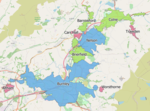Nelson F.C.
Nelson Football Club is a football club based in Nelson, Lancashire, England. Originally established in 1882, the club played in the Lancashire League, North-East Lancashire Combination, Lancashire Combination and Central League before becoming founder members of the Third Division North of the Football League in 1921. They were Division Three North champions in 1922–23 and were promoted to the Second Division. However, they were relegated back to the Third Division North after a single season. In 1931 the club lost their Football League status and returned to the Lancashire Combination, where following reformation in the summer of 1934 they played on until ceasing football activities in 1936. A new amateur club, Nelson Town, was quickly formed in the town, playing at Seedhill until the outbreak of World War II in September 1939. Following the resumption of football at the end of the war, Nelson FC reformed again in 1946. The reconstituted club joined the Lancashire Combination, playing in that league until it merged with the Cheshire County League to form the North West Counties League in 1982. They dropped out of the league between 1988 and 1992, playing in the West Lancashire League. Although the club left the league again in 2010, they returned the following year, and are currently members of the North West Counties League Division One North, playing home matches at Victoria Park.
Excerpt from the Wikipedia article Nelson F.C. (License: CC BY-SA 3.0, Authors).Nelson F.C.
Lomeshaye Way, Borough of Pendle Whitefield
Geographical coordinates (GPS) Address Nearby Places Show on map
Geographical coordinates (GPS)
| Latitude | Longitude |
|---|---|
| N 53.836572222222 ° | E -2.2291027777778 ° |
Address
Nelson Football Club
Lomeshaye Way
BB9 7BG Borough of Pendle, Whitefield
England, United Kingdom
Open on Google Maps









